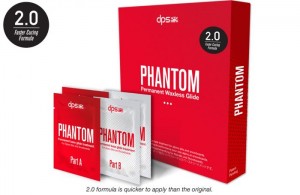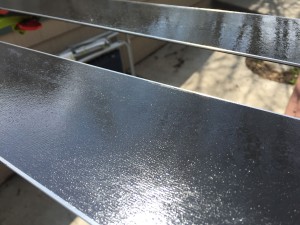The promise of Phantom from DPS sounds too much like a fairy tale to be believed â you never have to wax your skis again and your stick(s) will slide forever like they have been. As with many stereotypes, there is some truth in the pitch, but there are exceptions to the rule. When you read the full description DPS makes clear that Phantom won’t glide as well as the right wax done right, but as Thomas Laakso, VP of marketing at DPS says, âit gives a baseline level of glide that is better than a dry base.â
…Laakso’s claim is understated.
My experience would add some qualifications. For the temperatures you prefer to ski in, Phantom is far better than a dry base, potentially as slick as an unbuffed wax job when the temps are in the teens or twenties. In super cold (near or below 0 F) or sticky wet spring conditions it improves glide, but not dramatically. As with wax, a lot depends on how you attend to the details, especially for the finish. If you’re an avid waxer, you have the tools and know how. If you don’t, pay a pro to do it right.
Buff it Right
After applying Phantom 1.0 myself, and then letting the pros at The Bent Gate in Golden, Colorado apply v2.0, I venture to say Laakso’s claim is understated. When I did it myself with v1.0 the 3-hour cure time was a challenge to meet, even in âsunnyâ Colorado, thanks to con-trails veiling the sun. The results were suspect, but then, it turns out, so was my “waxing technique.” I’ve been known to not even scrape skis after waxing, so to expect me to buff the bases sufficiently was a stretch.
When I let Bent Gate’s Greg Harris do it, the baseline glide was evident right away. The reason for the difference was probably a combination of an improved Phantom formula that cures in only two hours under the sun (one hour for part A, and then another hour for part B), or one hour total in a cure station, plus sufficient scraping and brushing after each part was cured. DPS recommends you do the finish work as if you were buffing an application of wax for a race. A little buffing is good, more tends to be better.
In the associated video above I noticed that Part B didn’t absorb as well as it appeared to with v1.0. In reality, 1.0 didn’t soak in all that well either, but it smeared more evenly and Part B of v2.0 pooled up on the surface of part A with 2.0. DPS admits this happens âsometimes.â Part A may have needed more aggressive brushing after curing, so don’t be shy about that. You’re not scraping the Phantom off (it’s embedded), you’re scraping off the excess material that could prevent Part B from penetrating the base adequately.
With v1.0 I did scrape and brush after applying each part of the potion, but clearly not as thoroughly as the pros, or as much as DPS recommends. The good news is even with a hack application Phantom delivers decent results in the long run. In the short run you might notice some stickiness â especially if you didn’t buff the finish, like I didn’t. It took a couple yards for the grippiness to fade, which it did as I gained speed on my very first run in spring corn. Then, after a few days of spring tours I noticed it again on a flat stretch in single-digit cold packed powder, but once the angle grew glide took over. After a few thousand vert of cruising groomers at A-Basin the bases were buffed and now I reliably out-glide my friends who have no wax on their skis. This was undeniable on Butler Gulch where every extra inch of glide matters on the final mile of the low-angle trail out. With the 2.0 application done by Bent Gate, the glide came grudgingly for the first 10-20 feet, but that seems to be an insignificant aberration ever since. Glide is good and reliable in dry and packed powder so far. No data on spring slop, yet.
If this sounds like maybe the application process is still a bit finicky, DPS agrees. They’re in the beta phase of the next generation Phantom treatment that will be applied as a single “mixed” potion with a cure time of less than 15 minutes at a cure station. Look for that Fall 2019.
Wax still the best for glide
In sticky snow and in super cold snow you will probably still want to wax for optimal glide. That’s part of the beauty of Phantom. It isn’t a wax â it is a chemical treatment you add to the P-tex to enhance glide. It penetrates and remains in the p-tex. The problem with wax is it wears off. However, wax is still the best way to optimize glide, and according to DPS can be added âoverâ the Phantom treatment. Phantom is a great way to guarantee a minimum amount of glide, especially for when temps are above single digits (F ) and below freezing. In warm snow and super cold, Phantom is better than no wax, but you still might want to rub something on, or even do the full wax dance.
Preparation
Two things you can do to optimize the final effect of a Phantom base treatment. First, before applying, clean your bases â I’m a fan of citrus cleaners. Ideally you will have them ground first and while you’re at it, you should specify the structure you want â fine/coarse, linear/diamond/cross/arrow â for the dominant conditions you expect to ski in.
https://www.racewax.com/base-structure-theory/
https://the-raceplace.com/pages/ski-base-structure
Do it yourself or have the pros do it?
Having done both, I can assure you the cost to have the pros do it pays for itself in spades unless you have plenty of time to spare, or you love the whole art of waxing and have all the tools. If you’re doing the application yourself be prepared to scrape and buff like the pros. The second thing is that you want to mimmick the curing station as much as possible â meaning you want to subject your skis to the UV of sunlight in warm temperatures. For comparison, DPS curing stations run around 100 F, and take about 20 minutes per application. In ambient sunlight, DPS says an hour per ski, but I’d err on the side of more time for good measure.
Eco Friendly
A side benefit that DPS is making climate points with is how Phantom is more ecologically sound. It doesn’t rub off and distribute itself in the snowpack, and by extension, the environment that it flows through as the snow melts. I don’t know if all those flouro and parrafin compounds are causing any sort of measureable damage, but I won’t argue that leaving no trace is better than some trace, however miniscule. If Phantom causes cancer, we won’t know for at least 30 years, so you’re safe in that department for the forseeable future. 😉
Bottom line
Whether or not Phantom is worth the cost depends first on what your disposable funds are. After that, as a backcountry skier Phantom makes a lot of sense on a long tour where the wax will be gone before the first day is done, or you don’t have the time to wax, or you’re lazy. If you want the benefits of wax without the labor, DPS Phantom is singing your tune.
DPS
Phantom 2.0
MSRP: $100.00
Application: ~$50.00
© 2019



2 comments
In addition to the benefits cited in the review, you can add that you won’t get any more wax mixing with the glue on your skins. And as Dostie mentions, you can do multi-day tours without worrying about losing your wax job. Has worked exceptionally well for me on two pairs of skis during the NZ winter of 2018. At no point did I even think of, let alone wish for, a traditional wax job. Highly recommended.
I did the job myself. I sweated the detail regarding sunshine exposure and buffing and was it absorbing properly, and, and…. But it all turned out just fine. Very simple job to do successfully.
Although, I spoke with someone yesterday at the SIA/OR Snowshow in Denver about wax leaving a residue with Phantom treated skis. This is a nest of potential trouble that won’t be easy to untangle since glues vary by brand, model, and even the very day they are made. Some are good, some not so good. So BC skiers may find they still need to apply a wax to prevent skin glue residue – or buy new skins. Caveat emptor. YMMV.